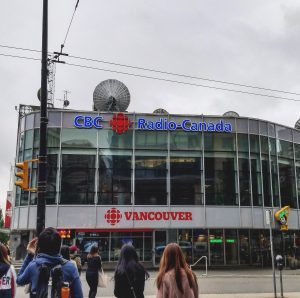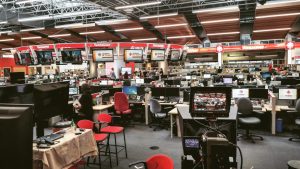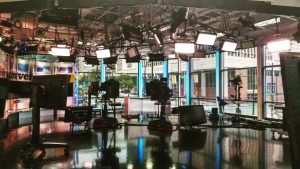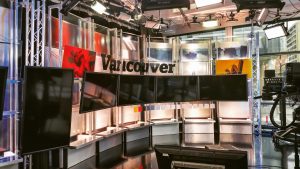
To me, the CBC Tour was a unique journey filled with lots of previously unimagined things. Not fit into my prediction, CBC Building is a very normal architecture, quietly standing on a normal street. What is more astonishing is the incredible scene inside the building. It was almost 9:30 AM when we arrived there, while there were very few people working in, with many working sets vacant.
As told by the guider, different news programs and 6 time-zones that Canada owns make staff work at different time slots of the day. Take National Newscast as an example, people related to this normally work in the latter part of a day. However, for some early morning newscast, some staff may start work at 5:00 AM. Though lots of the staff turn to work after lunch, I still noticed a group of people discussing in front of a big screen, which were the reporters in preparation for outside field reports.

As we stepped inside, it was getting much more capacious and there were various newsrooms located beside each other. This also surprised me that even just one floor could hold studios of different languages and functions. Now that I mention the structure of CBC, some numbers cannot be ignored. Compared to 3000 employees 30 years ago, CBC just has around 250 staff now. Thinking about this, I think it is really mentionable that people here definitely cooperate with each other in a high-efficiency atmosphere when facing so many various news programs.

Personally, I am also eager to become a photography journalist one day because I am so into taking photos as a record and observation of life. This is why I was excited and couldn’t wait to see a series of photography machines at the very beginning. Unlike the few people, there were quite a number of machines inside the building, which reminds me of the perfect combination of technology and journalism. Apart from this, at the end of the tour, there was a screen hanging on the wall, showing the official webpage of CBC. This also explains the important role that technology plays in journalism. Because it could not only update automatically every 20 seconds, but also show various data like number of visitors online, the most popular reports, number of people visiting the website at specific country around the globe and so on.
There are two small points arousing my interest as well. The first is that there are some specific staff in responsibility to check the CBC email-box from time to time, so as to gain some stories deserving to be reported as breaking news. There is even a fixed site for hosts to report the breaking news. This set of procedure made me have a better understanding of the timeliness of news. The second one is that in the studio for radio interviews, hosts are supposed to raise up valuable and inspiring questions towards guests rather than giving pure reports. In order to achieve this, the hosts are in need to learn some specialized knowledge from experts at as long as not the broadcasting time. I really think this is quite a good arrangement and requirement because this shows respect to both of the guests and audience, by making the newscast more professional.

Other interesting “secrets” I found were pedals and the “cough” button. The former one was set below the broadcasting desk. Owing to the strict time budget, if the hosts find they are running out of time, the pedal is used to be stepped down to speed up the rolling of the script. As for the “cough” button, it is prepared for speakers in radio studio whenever they need to have a rest. I think these two small facts are not only fun, but also shows the humanized concept.

The CBC tour is a really awesome and unforgettable journey. I had a photo with the broadcasting desk, pretending to be a host. Though looking a little bit nervous and shy, I believe with more experience accumulated in the future, I could be a good journalist no matter what post I am standing on.